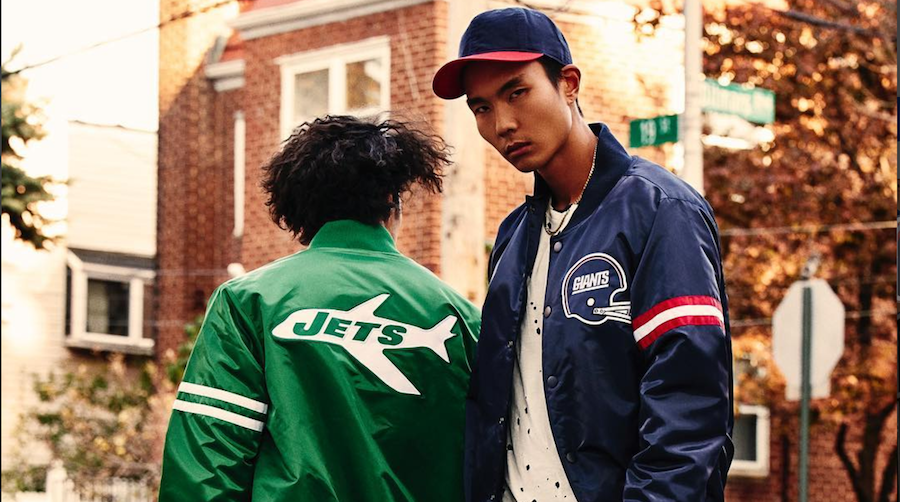G-III Apparel Group said its team sports business, which includes its sports licensing operations, “is booked well for fall,” while its core outerwear business is expected to see a healthy fall selling season.
Through the team sports business, G-III has licenses with the all four professional sports leagues, Hands High with Jimmy Fallon, Touch by Alyssa Milano and more than 100 U.S. colleges and universities. It also makes Starter jackets.
Robust backlogs and an above-plan second quarter prompted G-III to again raise its guidance for the year. Revenues are expected to be approximately $2.8 billion and net income between $1.11 and $1.21 per share. Previously, sales were expected to reach $2.76 billion with net income between $1.04 and $1.14 per diluted share.
In the second quarter ended July 31, revenues advanced 21.6 percent to $538 million. The company showed a net loss of $8.6 million, or 18 cents, in the period compared to a net loss of $1.3 million, or 3 cents, in the year ago period.
Previously, the company had forecast net sales of approximately $520 million and a net loss between $15 million and $20 million, or between 30 to 40 cents per share. Excluding non-recurring expenses related to its acquisition of Donna Karan International, the adjusted loss in the second quarter was 15 cents a share against earnings of 1 cent a year ago.
Sales were boosted by $45 million of net sales of DKNY and Donna Karan products but organic growth was still strong, up 12 percent.
Net sales from wholesale operation segment increased 30 percent to $468 million. Organic wholesale sales growth excluding Donna Karan was 20 percent in the quarter, driven by increases in net sales of its Tommy Hilfiger licensed products, which is now shipping products in all categories, as well as increases in net sales of Calvin Klein and Karl Lagerfeld licensed products.
On a conference call with analysts, Morris Goldfarb, chairman and CEO, said the company’s overall Calvin Klein business was up by an aggregate of 15 percent this past quarter. Calvin Klein dresses were up “solid double digits,” Sportswear is “doing very well” and Performance has been “outstanding.” Calvin Klein handbags continue to “grow nicely.”
Tommy Hilfiger sales overall were boosted by the rollout over the last year into women’s categories. Tommy Hilfiger dresses “performed exceptionally well” in the quarter while management was “pleased” with Hilfiger’s performance in newer categories: Performance, Sportswear and Denim. Hilfiger is expected to do in excess of $250 million of annual sales this year.
Karl Lagerfeld saw sales double off a modest base in the prior-year second quarter, led by dresses, shoes, handbags and sportswear. Among other brands, standouts in the second quarter were Eliza J and Vince Camuto dresses. The company is also confident that it will see full year net sales approaching $300 million for Donna Karan and DKNY.
In outerwear, a strong fall is expected from Calvin Klein and Tommy Hilfiger as well as over 25 percent growth in Levi’s outerwear. Goldfarb said the company has received reorders in outerwear starting about two weeks ago and early shipments are performing well.
“Our belief is that the second half of the year will be strong in outerwear,” said Goldfarb. “Our early reads are excellent and we believe that we’ll have a strong second half. Our retail partners inventory are all intact, whether it’s the off-price channel or the department store channel. There the levels don’t appear very high, there seems to be open-to-buy opportunity for pretty much every retailer that we trade with. The off-price channel seems to be nimble and prepared for growth and for buying more products as does the department store sector.”
Net sales of its retail operation segment increased 6 percent to $106 million due to the inclusion of net sales of $15 million from its new DKNY stores, offset in part by a decrease in net sales at its Wilsons Leather and G. H. Bass store chains. Same-store sales declined 4.3 percent at Wilsons and 5.2 percent at G. H. Bass.
Goldfarb said the company has eliminated $12 million of annual run rate expenses from its retail business and continues to focus on narrowing the segment’s losses. Wilsons and Bass store fleet began the current fiscal year with 353 locations, is now at 320, and expected to reach 285 by fiscal year-end, January 31, 2018. Mid-single digit sales comp gains are expected for both Wilsons and Bass in the second half.
Photo courtesy Starter
















